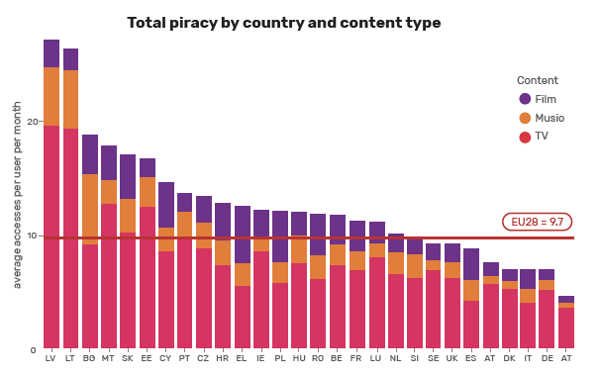Our latest report highlights the issue of video piracy in Eastern Europe and provides suggestions on how it can be combated.
 Video piracy is a growing problem around the world. The nature of the attacks and the strengths and weaknesses of the various methods chosen to combat it change with each country, however. This is why we have set up a series of reports looking at different territories. Our first report concentrated on the situation in Spain. For this second one, we have stayed on the same continent but moved the focus eastwards to Eastern Europe.
Video piracy is a growing problem around the world. The nature of the attacks and the strengths and weaknesses of the various methods chosen to combat it change with each country, however. This is why we have set up a series of reports looking at different territories. Our first report concentrated on the situation in Spain. For this second one, we have stayed on the same continent but moved the focus eastwards to Eastern Europe.
Video piracy is a growing problem here too, with illegal content access across the 22 countries that make up Eastern Europe trending above the monthly European average. It is a large market with an active Pay-TV sector. This is shrinking here, as it is in most regions around the world, but only very slightly with a 4% contraction forecast by 2024.
As a result, Eastern Europe as a whole is well insulated against the problems of cord cutting. The situation in the region though is not one of stasis; there are both numerous changes within those figures and there is an impressive growth forecast for the SVOD market in the same time period, up by 160%
There is also unfortunately a significant risk of video piracy in the region as the latest in our series of reports on piracy around the world shows.
Download Fighting Piracy Across The Globe: Spotlight On Eastern Europe now.
Piracy in Eastern Europe overview
Our report takes a deep dive into the situation in two countries, Poland and Croatia, contrasting the situation in two markets with quite differing demographics and different markets. Piracy is a problem in both, however, as it is across the region.
As the chart below shows, the average internet user in the 28 EU countries (the UK was still included when this EUIPO research was undertaken) visits an illegal site containing pirated TV content 9.7 times per month.
 Graphic: EUIPO
Graphic: EUIPO
As can be seen, TV is by far the most pirated media content and is significantly in advance of both music and film. The two outliers on the left hand of the graph are both Eastern European countries, Latvia and Lithuania. Each of these logs more than 26 accesses to illegal sites per month for all content.
While countries from elsewhere in Europe are present, by far the majority of states to the left of the diagram are from Eastern Europe. All in all, 1.2 million viewers from Eastern Europe are estimated to have accessed illegal IPTV services multiple times throughout 2018. And highlighting the recent move from the download/torrent model to real-time piracy, streaming was the most popular way of accessing illegal content, accounting for 75% of all access.
Details and actions
The full report has the full details. As well as the detailed pictures of the problem in Poland and Croatia, it gives actionable recommendations for how piracy in the region can be addressed. These fall into several different categories, from preventative measures to legal action, which is designed to help implement a holistic approach to the problem.
To help construct persuasive C-level arguments for investment in anti-piracy strategies, it also contains details of the free service we offer to operators and broadcasters providing a detailed Revenue Loss analysis of any individual company’s exposure to piracy. This analyzes the current content offering and cross-references it with the most up-to-date data regarding piracy in the Eastern European markets.
The result will be an accurate projection of how much they are currently losing per year to piracy in different program categories and different activities. This can then be compared to the cost of a coordinated anti-piracy strategy that aims to improve the conversion rate of illegal streamers to legal subscribers.
For more details and to discover the full nature of piracy in the region, Download Fighting Piracy Across The Globe: Spotlight On Eastern Europe now.
And watch out for Fighting Piracy Across The Globe: Spotlight On Southeast Asia - coming soon.
